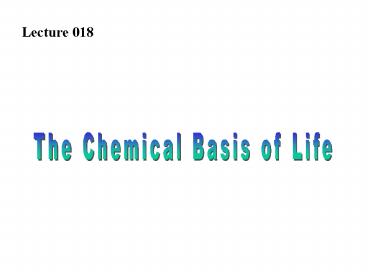The Chemical Basis of Life - PowerPoint PPT Presentation
1 / 50
Title:
The Chemical Basis of Life
Description:
electron sharing. O. H. H. Covalent Bonds. Between Water Molecules ... Cars, trucks, airplanes. The main chemicals. Sulfur dioxide. Nitrogen oxides. Acid Rain ... – PowerPoint PPT presentation
Number of Views:40
Avg rating:3.0/5.0
Title: The Chemical Basis of Life
1
Lecture 018
The Chemical Basis of Life
2
Levels of Sturctural Organization
- Atoms
- Molecules
- Organelles
- Cells
- Tissues
- Organs
- Organ Systems
- Organisms
- Populations
- Communities
- Ecosystems
- Biosphere
3
Levels of Sturctural Organization
4
Element
Pure substances that cannot be broken down into
simpler chemical entities by ordinary chemical
reactions
.
Periodic Table 112 known elements
5
(No Transcript)
6
Elements Atoms
An element is composed of atoms (0.1-1 nm in
diameter) Atom? cluster of small particles
(proton, neutron, electron)
7
Subatomic Particles
Protons (p ) Electrons (e -) Neutrons (n o)
8
Electron Configuration of Atoms
proton
neutron
electron
hydrogen atom
helium atom
carbon atom
1p, 0n, 1e-
2p, 2n, 2e-
6p, 6n, 6e-
9
atomic number number of p p e- 2He?2e-
and 2p
He
10
atomic mass (atomic wt.) sum of masses of
pn He? 2p 2n, atomic mass 4 4
2He
p n
e-
11
Carbon Atom
p n e- Atomic number Atomic mass
12
p e- 2He?2e- and 2p atomic number ? number
of p 2He atomic mass (atomic wt.)? sum of
masses of pn He? 2p 2n, atomic mass 4 4 2He
p n e- Atomic number Atomic mass
13
Isotope
Atoms that differ in the number of neutrons
16 8 O
18 8 O
17 8 O
pn
p
O16 O17 O18 stable isotopes
14
Molecule
Two or more atoms held together by chemical bonds
Oxygen O2 Nitrogen N2 Ammonia
NH3 Carbon Dioxide CO2 Water H2O M
ethane CH4 Glucose C6H12O6
15
Organic Molecules
- Carbohydrates C6H12O6 (glucose)
- Lipids C3H8O3 (glycerol) 3C16H32O2 (fatty
acids) - Proteins COOH-NH2
- Nucleic Acids sugar, PO4, N2 containing base
16
Compound
Binding two or more different kinds of elements
together
NaCl CH4 C6H12O6
17
Energy Levels
- Energy- the ability to do work
- Kinetic (energy in motion)
- Potential (stored)
18
Energy Levels
The different states of potential energy for
electrons in an atom are called energy levels or
electron shells.
Energy absorbed
3rd energy level
Energy lost
2nd energy level
1st energy level
nucleus
19
Energy takes on different forms in the body
- Chemical- ATP?ADP Pi (glycolysis)
- Mechanical- muscles moving, producing heat,
digestion - Electrical- charges particles Na/K, Ca, nerve
and muscle - Radiant (electromagnetic)- energy that travels in
waves (visible, UV, IR) ? - Retina,
light?skin?vitamin D
20
Ion
An atom that has either gained or lost electrons
such that it exhibits a net charge
Na Cl-
21
Sodium (Na) Atom
11 P 12 No
22
Sodium (Na) Ion
23
Chlorine (Cl) Atom
24
Chloride (Cl-) Ion
25
Examples of Ions
- Hydrogen H
- Potassium K
- Fluoride F-
- Calcium Ca2
- Magnesium Mg2
- Hydroxide OH-
- Bicarbonate HCO3-
- Nitrate NO3-
- Phosphate PO4-3
26
Bond Types
- Ionic
- Covalent
- Hydrogen
27
Ionic Bonds
Transfer of electron
17 P 18 No
28
electron sharing
Covalent Bonds
H
H
29
Between Water Molecules
Hydrogen Bonds
Hydrogen bond
Covalent bond
30
Chemical Reactions
31
Chemical Reactions
A ? B
reactant ? product
32
Chemical Synthesis
(anabolic)
A B ? AB
33
Chemical Decomposition
(catabolic)
AB ? A B
34
Chemical Rearangement
AB CD ? AC BD
35
Decomposition of Water
H2O ? H OH-
36
Respiration
C6H12O6 6O2 ? 6CO2 6H2O energy
37
Photosynthesis
6CO2 6H2O energy ? C6H12O6 6O2
38
ATP
39
Hydrolysis of ATP
ATP ? ADP Pi energy
40
Acids
Proton donor, i.e., they donate H ions HCl is a
strong acid with a pH 1-2
HCL ? H Cl-
41
Bases
Proton acceptor, i.e., they take up H ions NaOH
is a strong base pH 12
Na OH- ? NaOH NH3 H ? NH4 OH - H ?
H2O HCO3 H ? H2CO3
42
Neutralization- HCl NaOH? H2O NaCl Buffer-
resists dramatic changes in pH ex. tums,
rolaidsbuffers stomach acid
43
pH Scale
0-14
Type of Solution
pH Value
Neutral 7 Acidic 0-6 Basic (alkaline) 8-14
44
pH Scale
Logarithmic scale
45
Causes of Acid Rain
- Air pollution
- Burning of fossil fuels
- - Power plants
- - Cars, trucks, airplanes
- The main chemicals
- Sulfur dioxide
- Nitrogen oxides
46
Acid Rain
- Normal Rain
- H2O CO2 ? H HCO3-
- A pH of 5.6
- Water carbon dioxide ? proton carbonic acid
- Acid Rain
- Form of water pollution
- More acidic than normal rain
- Has pH lt 5.6
- nitrous dioxide water ? nitrous acid nitric
acid - 2NO2 H2O ? HNO2 HNO3
- sulfur dioxide water ? sulfuric acid
- SO2 H2O? H2SO4
47
Ecological Effects from Acid Rain in Lake System
- Changes begin to occur as soon as a lake starts
to lose it natural bases or alkalinity. - A large reduction in the number of plankton
invertebrates. - The rate of decomposition of organic matter
decreases - Direct effects on fishes reproductive cycles.
- A calcium deficiency in fish leads to bone
malformation. - Fish can suffocate as their gills become clogged
with aluminum hydroxide. - Songbirds are effected by eating insects
contaminated with toxic metals.
48
Effects from Acid Rain
49
Effects from Acid Rain
50
Acid Rain































